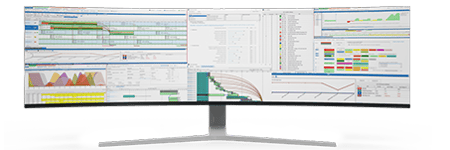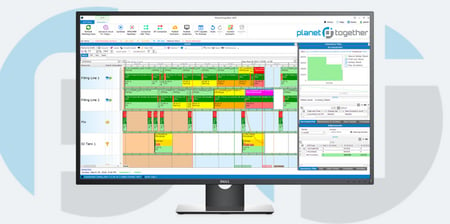Optimal Resource Utilization for Production Schedulers
The role of a Production Scheduler is essential for managing resources efficiently, ensuring smooth workflows, and minimizing downtime. However, balancing the many variables within production—such as labor, machinery, materials, and time—requires sophisticated tools and strategies. Achieving optimal resource utilization hinges on a blend of well-structured scheduling processes and technological solutions that provide real-time insights and actionable data. This is where integrating advanced scheduling platforms like PlanetTogether with enterprise resource planning (ERP) systems such as SAP, Oracle, Microsoft, Kinaxis, and Aveva can make a significant impact. By fostering a more connected production environment, this integration empowers schedulers to refine their strategies, streamline operations, and drive overall productivity.

Optimal Resource Utilization in Industrial Manufacturing
Optimal resource utilization is the strategic use of resources—human, material, or machine—to achieve maximum productivity without waste. In industrial manufacturing, this often means:
- Minimizing downtime: Ensuring machines and labor resources are always in use without overstraining.
- Reducing waste: Avoiding unnecessary use of materials and energy.
- Balancing workloads: Preventing bottlenecks or resource idle times across various production stages.
- Improving quality: Utilizing resources effectively to maintain product quality standards.
- Enhancing flexibility: Adapting schedules and resource allocation based on real-time demands and changes.
An effective production schedule plays a central role in optimizing resource utilization. However, traditional scheduling methods often fall short in adapting to real-time changes, and this is where integrating PlanetTogether with ERP systems becomes crucial.


The Power of PlanetTogether Integrated with ERP Systems
PlanetTogether is an advanced production scheduling and planning tool that allows for detailed visualization and optimization of workflows. When integrated with ERP systems like SAP, Oracle, Microsoft, Kinaxis, or Aveva, it offers seamless data flow and real-time updates across the organization, providing Production Schedulers with the visibility and control they need.
Some key benefits of this integration include:
Real-Time Data Sharing: Production schedules are only as effective as the data behind them. Integrating PlanetTogether with an ERP system provides immediate access to up-to-date information on materials, labor availability, machine status, and demand forecasts, enabling Production Schedulers to make informed adjustments on the fly.
Enhanced Collaboration Across Departments: Data synchronization between PlanetTogether and ERP systems ensures that departments such as procurement, quality assurance, and maintenance are aligned. This reduces the chances of miscommunication, enhances cross-departmental collaboration, and keeps all teams working towards the same objectives.
Predictive Analytics and Scenario Planning: PlanetTogether, in combination with ERP systems, supports predictive analytics, which can identify potential bottlenecks and recommend preventive actions. This integration also facilitates scenario planning, enabling Production Schedulers to simulate different resource allocation strategies and determine the most effective approach before implementing changes on the floor.

Key Strategies for Optimal Resource Utilization through Integration
Improved Demand Forecasting and Inventory Control
With a seamless connection between PlanetTogether and an ERP system like Kinaxis, production schedules can adapt quickly to changes in demand. The ERP’s demand forecasting capabilities feed data into PlanetTogether, allowing schedulers to plan for fluctuations by adjusting resource allocations accordingly. This results in:
Reduced stockouts for high-demand products.
Minimized excess inventory for low-demand items.
Better alignment between production schedules and market demands.
For instance, when a demand surge for a particular product is identified, Production Schedulers can immediately allocate more labor and machine resources to meet the new requirement without waiting for manual input or approvals, reducing delays.
Efficient Labor Allocation
Labor is one of the most critical resources in industrial manufacturing, and its availability often fluctuates. Through integration with ERP systems, PlanetTogether can access real-time data on labor availability, qualifications, and shift schedules. By using these insights, Production Schedulers can allocate the right people to the right tasks, ensuring:
Reduced overtime costs by spreading work evenly.
Avoidance of underutilized labor, especially during non-peak hours.
Improved employee satisfaction due to balanced workloads.
This can be particularly impactful when integrated with a system like SAP, which often contains comprehensive data on labor schedules, absences, and qualifications, giving PlanetTogether the intelligence it needs to make optimal assignments.
Streamlined Maintenance and Downtime Scheduling
In industrial settings, machine uptime is directly linked to production output. Integrating with systems like Oracle or Aveva, which often include predictive maintenance modules, allows PlanetTogether to factor in scheduled maintenance activities when planning production. This approach benefits schedulers by:
Preventing unplanned downtime by scheduling maintenance during non-peak production periods.
Optimizing machine usage by aligning production schedules with maintenance windows.
Enhancing long-term asset health, leading to fewer disruptions and higher productivity.
A real-world example might involve using predictive data from Aveva to adjust machine allocation in PlanetTogether. When maintenance is anticipated, schedulers can reschedule work to other available equipment, ensuring continuity.
Dynamic Material Requirement Planning (MRP)
Integration between PlanetTogether and ERP systems like SAP or Oracle enhances Material Requirement Planning (MRP) by allowing Production Schedulers to access real-time inventory levels and lead times for raw materials. This ensures that:
Materials are available exactly when needed, reducing storage costs.
Production delays due to material shortages are minimized.
Supply chain flexibility is increased, especially during periods of material scarcity.
By automating MRP adjustments based on actual material availability, Production Schedulers are empowered to allocate resources more precisely and maintain production flow, even when facing supply chain disruptions.
Increased Agility with Scenario Analysis and Simulation
PlanetTogether’s integration with ERP systems enhances scenario analysis, enabling Production Schedulers to test different “what-if” scenarios before committing to a production schedule. This helps schedulers:
Identify optimal resource allocation strategies across multiple scenarios.
Mitigate risks associated with sudden demand spikes or supply chain delays.
Respond proactively to market changes by adjusting production schedules in advance.
For instance, in collaboration with Microsoft’s Power BI integration, Production Schedulers can visualize the impact of different scheduling decisions on overall resource utilization and productivity.

Realizing the Full Potential of ERP-Integrated Production Scheduling
To harness the full potential of these integrations, Production Schedulers need to focus on the following best practices:
Ensure Accurate Data Input: The quality of output from any scheduling software depends on the quality of data input. Regular audits of data sources, including inventory levels, labor schedules, and machine statuses, ensure that the insights generated by PlanetTogether and the ERP system remain accurate.
Regularly Update Scenario Models: Scenario planning is most effective when models are regularly updated to reflect current operational conditions. By revisiting and refining models as production and market conditions evolve, schedulers can maintain a high level of responsiveness and preparedness.
Leverage Predictive Analytics Actively: The predictive capabilities of ERP systems, when used with PlanetTogether, can forewarn Production Schedulers of potential resource constraints. Training schedulers to interpret and act on predictive insights allows for more proactive scheduling.
Foster Interdepartmental Communication: The success of resource optimization hinges on collaboration. Integrating PlanetTogether with ERP systems creates a shared platform for cross-departmental visibility, which can enhance communication between production, procurement, quality control, and maintenance teams.
For Production Schedulers in industrial manufacturing, achieving optimal resource utilization is critical to driving efficiency, productivity, and profitability. The integration of PlanetTogether with ERP systems like SAP, Oracle, Microsoft, Kinaxis, and Aveva empowers schedulers to make data-driven decisions, streamline workflows, and optimize every facet of production. By combining real-time insights, predictive analytics, and scenario planning, this integration offers a comprehensive approach to managing resources effectively.
In a world where manufacturing demands are becoming increasingly complex, the ability to adapt quickly and utilize resources optimally can set an organization apart. With the right integration strategy, Production Schedulers can navigate the challenges of modern manufacturing, reduce costs, and contribute to a more resilient and efficient production environment.
Are you ready to take your manufacturing operations to the next level? Contact us today to learn more about how PlanetTogether can help you achieve your goals and drive success in your industry.